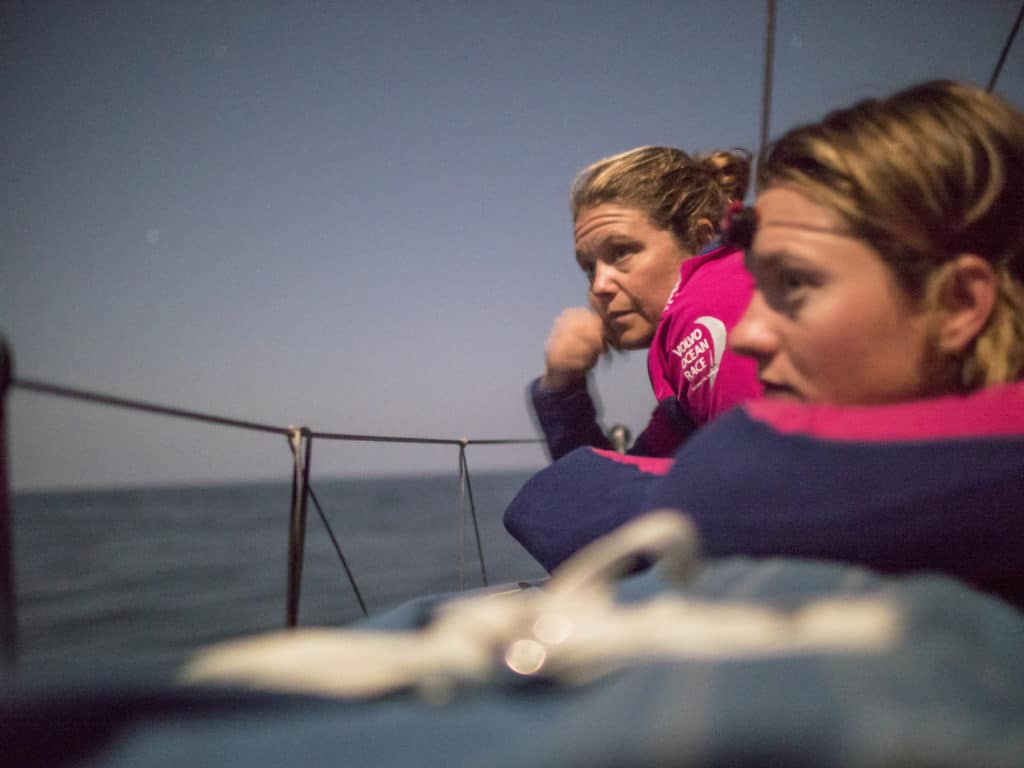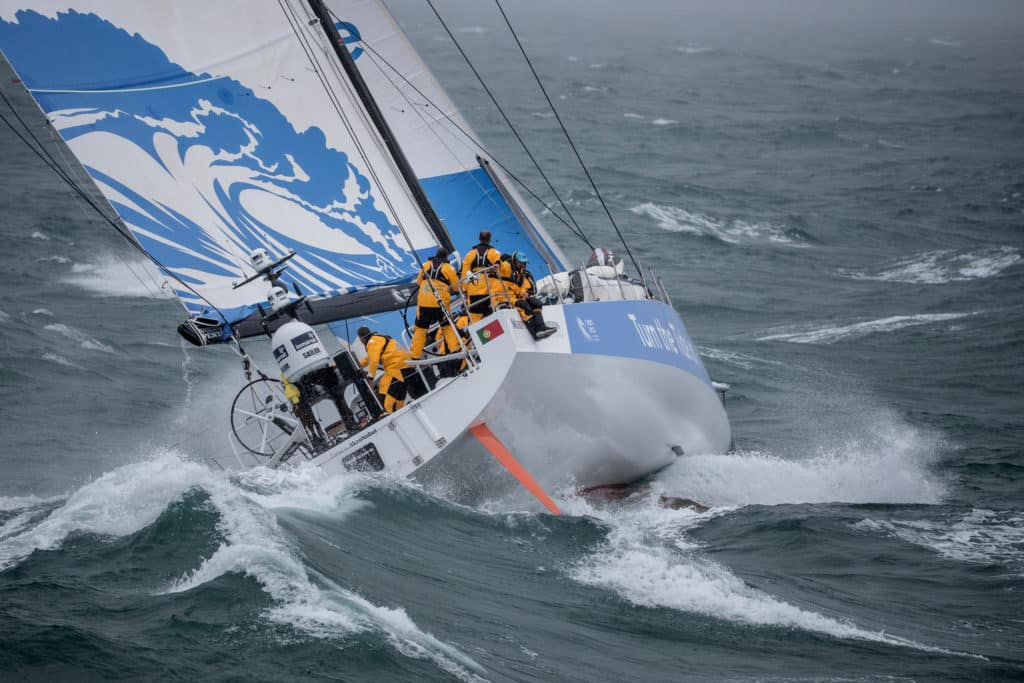
One of the greatest joys in sailing is racing offshore. The freedom and the changeable beauty of the sea and elements provide the most magnificent backdrop to a competitive environment. The camaraderie of a crew experiencing life at sea together is always unique. Through my own experiences, I have learned to appreciate the weather, the water, the scenery, the sea life and the infinite mosaic of images that make sailing long distances invigorating. Regardless of how I might place in a race, the experience and rewards are always extraordinary. It is true: Life ashore is quite ordinary, but life at sea is anything but. It’s something all sailors should experience at one time or another, yet access to offshore racing can be hard, or nearly impossible to come by. And this is especially true for women.
The Storm Trysail Foundation, however, has an initiative to encourage more women to participate in distance racing. As part of this program, the foundation’s leadership recently produced a film featuring 10 highly acclaimed female offshore sailors who share their diverse experiences. I had the good fortune to conduct the interviews with these sailors, all of whom are members of the Storm Trysail Club. Their thoughts were extremely helpful in understanding the barriers and opportunities for women sailors today.
Sally Honey, a two-time Rolex Yachtswoman of the Year, has won the Transpac Race, cruised extensively with her husband, Stan, and remains enthusiastic about sailing offshore. She attributes it to the wonderful feeling she gets when she’s in the middle of nowhere, with just the stars, the wind and the water. “You have to rely on the people who are on the boat with you, and yourself,” she says. “It is unlike anything you get in your normal life ashore.”
Dawn Riley, another yachtswoman of the year, and now a mentor to hundreds of sailors who pass through the glass door at Oakcliff Sailing Center on Long Island, says: “The coolest thing about being offshore is the vast amount of water to cover. There is a lot of stuffing going on at sea.”
Riley has been outspoken about women in sailing but looks ahead and says: “Women in leadership roles with decision-making power is where we need to go. You need to prove yourself. Once you are on the boat, and actually sailing and doing your job, then you’re accepted.”
Sheila McCurdy is a past commodore of the Cruising Club of America and a veteran of 10 trans-Atlantic crossings, an accomplishment to which very few sailors can lay claim. She has a simple philosophy about bluewater sailing. “It’s singular,” she says. “It’s simple because your world shrinks down to the size of the boat. You control everything on that boat. You get into a rhythm of going on and off watch. It almost feels like it’s going to be too much trouble to arrive, you’re so relaxed and in the rhythm of the boat.”
As romantic as the notion of going offshore might be, having the opportunity to do so is a whole different story, but veteran offshore racer Martha Parker suggests it can be as easy as putting up your hand and being available.
“Bigger boats are always looking for crew,” she says. “If you can be consistent and commit, you are going to be valuable. Start with a smaller boat, don’t be bashful, and just ask, ‘Can I go?’” She adds, “Find out who is organizing the crew, and remember that attitude is the most important aspect that you bring.” Those skills, paired with a good attitude and a thirst for success, make you a valuable teammate.

Madeleine Ploch, a 16-year-old high school student who raced on board High Noon in the 2016 Newport to Bermuda Race, was one of a crew of teenagers that won its class, placing third overall in its division. From the experience, Ploch learned that organized training will encourage more of her peers to race offshore. “Many of the yacht clubs on Long Island Sound have programs. Start with shorter races, and then you could do longer ones. Any girl can be an amazing offshore sailor if she gets a crew she trusts and does enough practice. It’s all about preparation and making sure you know yourself and your own limits.”
One of her shipmates is Carina Becker, 18, and she has the same dirt-under-her-fingernails pride as Parker about being a skilled female member of the crew. “People need to just walk aboard and not feel like they’re different. If you say, ‘I’m here to sail,’ people are going to say, ‘OK, here are some sheets.’”
Dr. Kim Zeh, a medical doctor, suggests maintaining good physical fitness. “Total body conditioning and agility is very important,” she says. “You never know when you might have to fill in for someone. So you have to be prepared. Understand at least one other position. I became more valuable on a boat when I learned about marine engines and got educated about navigation.”
Renee Mehl, a Whitbread Round the World Race veteran and offshore sailing coach at the U.S. Naval Academy, spends her time training midshipmen who are new to sailing and learning to go to sea. Mehl suggests the more-experienced racers in the sailing community should help the novices. “At the academy, we encourage the upper class to mentor and teach the third class. It is up to the skipper to show the newbies around, make them familiar with the boat, and then teach them their job.”
Linda Weiss races with her family on the successful yacht Christopher Dragon. She had a different approach when she started out racing offshore. “My first sailing was with a bunch of ladies. It was quite unique at the time. They were all so helpful teaching somebody who was eager to sail. When I started sailing with men, everyone was very polite and asking me to move from one side to the other.” Weiss, however, laughs and adds, “Now I get yelled at like everybody else, so I’ve arrived as a real crewman.”
One of the questions that intrigued me during our interview sessions was learning if there were any skill sets in which women excel. Several sailors talked about the ability to focus on an assigned task (and not multitask), to stay organized, and to be calm in difficult situations.
One of America’s great sailors is Sally Barkow, from Wisconsin. She is an Olympian and competed in the last Volvo Ocean Race with Team SCA. Keep in mind the Volvo Ocean Race is one of the toughest physical tests in sailing. Barkow is now one of the founders of the Magenta Project, which is dedicated to accelerating women in sailing, as well as in the industry, by creating pathways, empowering leadership, and driving change. One of the group’s goals is to get more women on Volvo teams. At this writing, there are five signed up for the next edition beginning in October.
“Women need to get skills to own the sport of sailing,” says Barkow. “We want to provide an educational platform to provide mechanical skills. Most college sailors don’t know what is available. We want to help provide the information that women have many opportunities.”
The 10 sailors featured in Storm Trysail Club’s film discuss a wide variety of topics, including why they sail offshore, learning to gel as a part of a team similar to every other sport, the importance of sail training, items for your personal offshore kit, proper clothing, good teamwork, effective communications, how to develop a specific skill, personal hygiene, and several great stories based on their collective experiences.
In the film, Parker speaks about what is like to be the only female on a boat. “I always say, ‘Don’t have a chip on your shoulder.’ Just go out there because you love sailing, you’re passionate about it, and you want to be part of the team. Remember every person is important. Your team is only as strong as your weakest link. Everyone can work together to bring that team up.”
In the process of writing this article, I learned that our new associate editor, Ellinor Walters, is an avid sailor, who is a recent graduate of the College of Charleston and who also attended Ashley Hall, an all-girls high school in Charleston. She told me that the students were inspired by the school’s motto, “Girls who have the will, have the ability.” The phrase is appropriate for aspiring offshore sailors.









